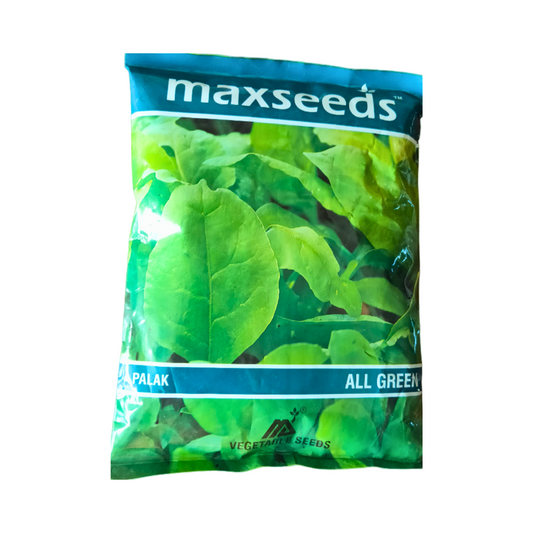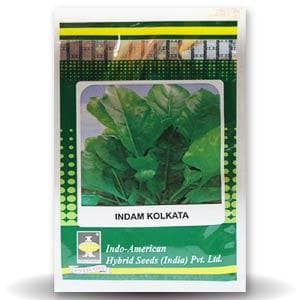Buy Spinach(Palak) Seeds from various brands at DesiKheti:
Buy Indo American Seeds Spinach (Palak) Seeds Online
Buy Max Seeds Spinach (Palak) Seeds Online
Buy Sarpan Seeds Spinach (Palak) Seeds Online
Buy Welcome Seeds Spinach (Palak) Seeds Online
The scientific name of Spinach is Spinacia oleracea. Spinach belongs to the Amaranthaceae family and is native to Central and Western Asia. Spinach is grown around the world. Spinach is also known as Palak in India. Spinach is a versatile vegetable with a wide range of uses.
Spinach is rich in iron, vitamins, and antioxidants. It is not only nutritious but also packed with health benefits. Palak boosts immunity, aids digestion, and is good for the eyes, skin, hair, and brain. It is also known for its anti-cancer and anti-ageing properties, making it a great addition to any diet.
In India, states like Andhra Pradesh, Telangana, Kerala, Tamil Nadu, Uttar Pradesh, Karnataka, Maharashtra, West Bengal, and Gujarat are known for their abundant Palak cultivation, benefiting from the favourable growing conditions these regions offer.
Climate for Spinach Cultivation
Spinach plants do not grow well in hot weather. Spinach grows well in the cool season. However, Palak grows slowly when the temperature drops below 10°C. The ideal temperature for the growth of Palak is 18 to 20°C. Spinach is a short-day plant.
Soil for Spinach Farming
Spinach can grow in different types of soil, but it does best in soils with good drainage and high moisture retention. For optimal productivity of Palakura, sandy loam or alluvial soils are suitable. However, Palak doesn't perform well in acidic or waterlogged soil. The recommended soil pH for healthy growth of Palak is between 6 to 7.
Land Preparation for Sowing Spinach Seeds
The soil should be thoroughly ploughed two to three times and levelled to ensure even bed formation. Apply 100 quintals per hectare of well-rotted FYM during Land preparation.
Seed
Spinach Seeds and Propagation Material
Selection of a Spinach Variety: When selecting a Spinach variety, factors such as climate, soil type, and local market preferences should be considered.
Procurement of Quality Spinach Seeds: To achieve the best results, Spinach seeds should be sourced from reputable companies. At Desikheti, we offer a wide variety of high-quality Spinach seeds, with the added convenience of doorstep delivery.
Spinach Seed Rate: For the winter season, generally around 4 to 6 kg of spinach seeds are sown per acre, and for the summer season, 10 to 15 kg of spinach seeds are sown per acre of land.
Spinach Seed Treatment: Spinach seeds sold by private companies are generally treated with chemicals. If untreated seeds are purchased, it is recommended to treat them Captan at 2 g per kg of seed to prevent soil-borne diseases and ensure healthy crop growth.
Time of Sowing Spinach Seeds
Spinach can be grown year-round, but the ideal sowing time varies depending on the region and the season. For the winter season, the best time to sow Palak is from September to October. In the spring, the sowing of Spinach seeds is generally done between mid-February and April.
Method of Sowing Spinach Seeds
Spinach seeds can be sown using either the broadcasting or line sowing method. The Line-sowing method is typically preferred as it makes other crop management practices easier. For line sowing, maintain a spacing of 30 cm between rows and 10-12 cm between Palakura plants. The Palak seeds need to be sown at a depth of 3-4 cm to ensure proper growth.
Nutrient Management for Spinach Farming
The exact fertilizer recommendations vary based on region. Generally, 75 kg of nitrogen (N), 55 kg of phosphorus (P), and 30 kg of potassium (K) are applied per hectare. Half of the Nitrogen, an entire quantity of phosphorus and potassium is applied as a basal dose during the final ploughing. The other half of the nitrogen is applied one month after sowing spinach seeds.
Irrigation Management for Spinach Farming
Spinach is a fast-growing, shallow-rooted crop that is sensitive to water stress. It is important to maintain adequate moisture in the soil to ensure proper Spinach seed germination and healthy growth of spinach plants. If the soil is dry at the time of sowing Palak seeds, pre-sowing irrigation can be given. The first irrigation should be applied immediately after sowing Palak seeds, and subsequent irrigations can be provided as needed.
Irrigation should be done based on requirements, but it is crucial to avoid practices that splash water onto the Palak leaves. Additionally, it is important to avoid waterlogging in the Palakura farm.
Weed Management for Spinach Farming
To manage weeds effectively, it's important to carry out one or two shallow hoeings, helping to keep the soil clear and support healthy plant development. As Palak plants have shallow roots, care should be taken not to damage the plant roots during weeding.
Pest and Disease Management in Spinach Farming
Common pests of Spinach
Spinach blue beetle (Altica caerulescens)
- When the grubs first emerge, they scrape and feed on the chlorophyll-rich areas of the Spinach leaves.
- Later, the grubs mine into the Palak leaves and feed on the mesophyll tissue.
- In their adult stage, they nibble on the edges of the Palak leaves.
Aphids (Myzus persicae)
- Both adults and nymphs infest tender shoots and the undersides of Spinach leaves.
- They suck the sap and cause Palak leaves to curl and crinkle, leading to stunted growth.
- The excretion of honeydew promotes the growth of black sooty mould on the Palak plant.
Leaf eating caterpillar (Laphygma exiqua)
- Caterpillars feed on Spinach leaves
- The feeding results in holes in Palak plant leaves.
Common Diseases of Spinach
Spinach mosaic (Cucumber mosaic virus)
- The affected Spinach leaves become smaller and distorted and may develop pale, almost white, chlorotic spots.
- The disease is characterized by irregular Light to dark green patches and mosaic-like patterns.
Downy mildew (Peronospora farinosa f. sp. spinaciae)
- In the initial stage, dull to bright yellow spots appear on the cotyledons and leaves of the spinach plant.
- As the disease progresses, these spots enlarge and turn brown and dry.
- In severe cases, the Palak leaves become curled and distorted, and they have a blighted effect.
Anthracnose (Colletotrichum dematium)
- In the early stages, small, circular, water-soaked lesions appear on Spinach leaves.
- In the later stages, the lesions turn brown and become thin and papery.
- As the disease progresses, these lesions merge, causing the Palak leaves to dry out.
Spinach Harvesting
Spinach is typically ready for harvest 4 to 6 weeks after sowing Spinach seeds. To harvest, use a sharp knife or sickle to make clean cuts. Harvesting should be avoided early in the morning when the leaves are crisp and prone to breaking easily. Depending on growing conditions, 3 to 4 harvests can be obtained throughout the season.
Spinach Yield
The yield of Spinach varies based on farm management practices and the variety used. On average, Spinach yields between 100 to 125 quintals per acre.

 Sold out
Sold out

 Sold out
Sold out Sold out
Sold out Sold out
Sold out Sold out
Sold out







